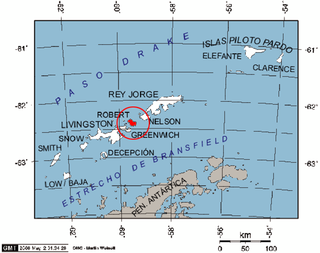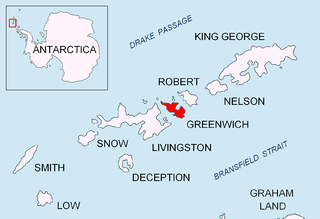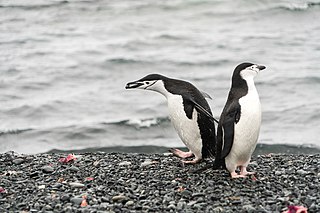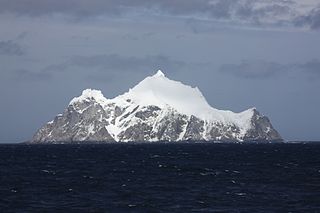
The South Shetland Islands are a group of Antarctic islands with a total area of 3,687 km2 (1,424 sq mi). They lie about 120 km (75 mi) north of the Antarctic Peninsula, and between 430 km (270 mi) to 900 km (560 mi) southwest from the nearest point of the South Orkney Islands. By the Antarctic Treaty of 1959, the islands' sovereignty is neither recognized nor disputed by the signatories and they are free for use by any signatory for non-military purposes.

The South Orkney Islands are a group of islands in the Southern Ocean, about 604 kilometres (375 mi) north-east of the tip of the Antarctic Peninsula and 844 kilometres (524 mi) south-west of South Georgia Island. They have a total area of about 620 square kilometres (240 sq mi). The islands are claimed both by Britain, and by Argentina as part of Argentine Antarctica. Under the 1959 Antarctic Treaty, sovereignty claims are held in abeyance.

Smith Island is 20 miles (32 km) long and 5 miles wide, lying 45 miles (72 km) west of Deception Island in the South Shetland Islands of the British Antarctic Territory. Surface area 148 square kilometres (57 sq mi).

Robert Island or Mitchells Island or Polotsk Island or Roberts Island is an island 11 miles (18 km) long and 8 miles (13 km) wide, situated between Nelson Island and Greenwich Island in the South Shetland Islands, Antarctica. Robert Island is located at 62°24′S59°30′W. Surface area 132 km2 (51 sq mi). The name "Robert Island" dates back to around 1821 and is now established in international usage.

Bransfield Strait or Fleet Sea is a body of water about 100 kilometres (60 mi) wide extending for 300 miles (500 km) in a general northeast – southwest direction between the South Shetland Islands and the Antarctic Peninsula.

Wulfila Glacier is located on the southern slopes of Breznik Heights, Greenwich Island in the South Shetland Islands, Antarctica, south-southwest of Solis Glacier and west of Zheravna Glacier. It is bounded by Oborishte Ridge to the northwest, Nevlya Peak to the north, Terter Peak and Razgrad Peak to the northeast, and Ephraim Bluff to the southeast. The glacier extends 3 km in northwest-southeast direction and 2 km in northeast-southwest direction. It drains southwestwards into McFarlane Strait between Ephraim Bluff and the base of Provadiya Hook, feeding the head of Doris Cove.

The Shetland Plate, or South Shetland Plate, is a tectonic microplate located off the tip of the Antarctic Peninsula and contains the South Shetland Islands. The plate is bordered on three sides by the Antarctic Plate and the fourth side is bordered by the Scotia Plate. The northwestern border is defined by the South Shetland Trench separating the Shetland Plate to the south from the Antarctic Plate to the north. This trench is the remnant of a subduction zone where the defunct Phoenix Plate, now part of the Antarctic Plate, subducted under the Antarctic Peninsula and the Shetland Islands. The southeastern border is rift zone with the Antarctic Plate creating the Bransfield Basin. The southwestern and northeastern boundaries are each part of larger fracture zones. The southwestern border is the Hero Fracture Zone and separates the Antarctic Plate to the southwest from the Shetland Plate to the northeast. The northeastern boundary is the Shackleton Fracture Zone and separates the Shetland Plate to the southwest from the Scotia Plate.

Coppermine Peninsula is the 1.7 km long, 500 m wide and rising to 105 m rugged rocky promontory forming the northwest extremity of Alfatar Peninsula and Robert Island in the South Shetland Islands, Antarctica and lying between English Strait to the west and Carlota Cove to the east. It is linked to Alfatar Peninsula to the southeast by a narrow isthmus bounded by Carlota Cove to the north and the 1 km wide and 460 m indenting Coppermine Cove to the south. The feature is named in association with the adjacent Coppermine Cove, a descriptive name given by sealers in about 1821 from the copper-coloured staining of the lavas and tuffs in the area.

Ash Point is a rounded low ice-free point forming the southeast side of the entrance to Discovery Bay in the northeast of Greenwich Island in the South Shetland Islands, Antarctica with an adjacent ice-free area of 201 hectares. Letelier Bank is lying off Ash Point, while Bascopé Point is situated 460 m (503 yd)to the southwest, with the 1 km (0.62 mi) wide Rojas Cove indenting for 310 m (339 yd) the coast between that point and Guesalaga Peninsula. The area was visited by early 19th century sealers.

Cecilia Island is the ice-free southernmost island of the Aitcho group on the west side of English Strait in the South Shetland Islands, Antarctica. Extending 910 by 450 m, surface area 36 hectares. The area, visited by American and English sealers in the early 19th century, nowadays has become a popular tourist site frequented by Antarctic cruise ships.

Fuerza Aérea Glacier is a glacier on Greenwich Island in the South Shetland Islands, Antarctica, extending 4.5 kilometres (2.8 mi) in a northeast–southwest direction and 2 kilometres (1.2 mi) in a southeast–northwest direction and draining the northwest slopes of the Breznik Heights to flow northwestwards into Discovery Bay.

Frederick Rocks is a group of rocks lying in Barclay Bay on the north side of Livingston Island in the South Shetland Islands, Antarctica. The area was visited by early 19th century sealers operating on nearby Byers Peninsula.

Figueroa Point is an ice-free point at the northeast extremity of Greenwich Island in the South Shetland Islands, Antarctica forming the southeast side of the entrance to Galápagos Cove. Dovizio Rock is lying 190 m (210 yd) to the northeast, Ibar Rocks are centred 860 m (940 yd) to the southeast, Bonert Rock62°27′01.8″S59°42′58.3″W is 730 m (800 yd) to the south-southeast and Rosales Rocks62°26′57.5″S59°43′16.4″W are 500 m (550 yd) south by east of Figueroa Point. The area was visited by early 19th century sealers.

Risopatrón Base, also Luis Risopatrón Base, is a small Chilean Antarctic research base in the northwest of Robert Island in the South Shetland Islands, Antarctica situated on the isthmus linking Coppermine Peninsula to Alfatar Peninsula and bounded by Carlota Cove to the north and Coppermine Cove to the south. Established as a refuge in 1949 and opened as a base in 1954, the facility supports summer research in geology, geophysics and terrestrial biology.

Orsoya Rocks is the group of rocks off the north coast of Robert Island in the South Shetland Islands, Antarctica, situated west-northwest of Mellona Rocks, north-northeast of Milev Rocks and east-northeast of Opaka Rocks, and extending 650 m in northwest-southeast direction and 500 m in northeast-southwest direction.

Pottinger Point is a low-lying, ice-free promontory 4 km (2.5 mi) east of Round Point, about 500 m long, on the north coast of King George Island in the South Shetland Islands of Antarctica. It was named by the United Kingdom Antarctic Place-Names Committee (UK-APC) in 1960 for Captain Pottinger, Master of the Tartar from London, who visited the South Shetland Islands in 1821–22.

Sugarloaf Island is a conspicuous small island which lies close to the east side of Clarence Island, midway between Cape Lloyd and Cape Bowles, in the South Shetland Islands, Antarctica. It lies 3.2 km north of Lebed Point, on the northern side of the entrance to Istros Bay. The name was in use by American and British sealers as early as 1822 and is now well established.

The Bransfield Basin is a back-arc rift basin located off the Northern tip of the Antarctic Peninsula. The basin lies within a Northeast and Southwest trending strait that separates the peninsula from the nearby South Shetland Islands to the Northwest. The basin extends for more than 500 kilometres from Smith Island to a portion of the Hero Fracture Zone. The basin can be subdivided into three basins: Western, Central, and Eastern. The Western basin is 130 kilometres long by 70 kilometres wide with a depth of 1.3 kilometres, the Central basin is 230 kilometres long by 60 kilometres wide with a depth of 1.9 kilometres, and the Eastern basin is 150 kilometres long by 40 kilometres wide with a depth of over 2.7 kilometres. The three basins are separated by the Deception Island and Bridgeman Island. The moho depth in the region has been seismically interpreted to be roughly 34 kilometres deep.

Dzhegov Rock is the solitary rock in eastern Prince Charles Strait, South Shetland Islands in Antarctica extending 40 m in southeast-northwest direction and 30 m in southwest-northeast direction. It is “named after Captain Simeon Dzhegov (1938-2011), Director in 1987 of the Bulgarian company Ocean Fisheries – Burgas whose ships operated in the waters of South Georgia, Kerguelen, the South Orkney Islands, South Shetland Islands and Antarctic Peninsula from 1970 to the early 1990s. The Bulgarian fishermen, along with those of the Soviet Union, Poland and East Germany are the pioneers of modern Antarctic fishing industry.”













